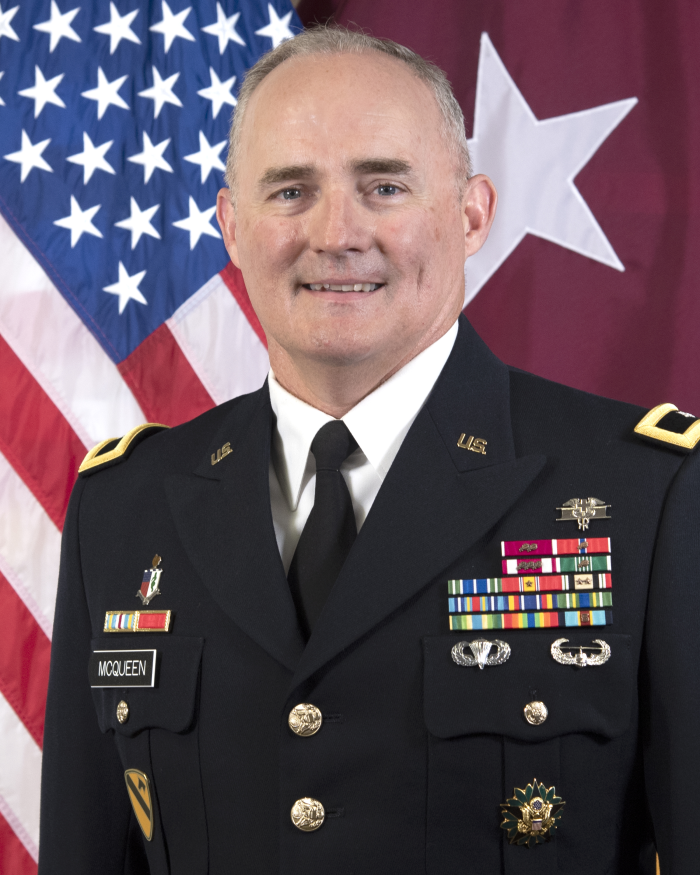Form Meets Function as McQueen Takes Lead at USAMRDC

Brig. Gen. Anthony McQueen, the new and current Commanding General of both the U.S. Army Medical Research and Development Command and Fort Detrick, Maryland, has a piece of advice he likes to give new recruits to the Army. It is, in his own words, a sort of brief – but beneficial – slice of guidance gleaned from his own 30-year Army career.
“You should have a plan of what you want to do,” says McQueen, cycling through a line he’s delivered hundreds of times before, “but it’s really about the opportunities that are going to present themselves to you along the way.”
The message is clear: in McQueen’s view, it’s important to do everything possible to prepare yourself for future opportunities while also remaining open to the unexpected. It’s a piece of advice that could also, in a way, double as his own personal mission statement – a simple, one-sentence treatise on how he approaches new challenges of all shapes and sizes. Now, as he takes command of the USAMRDC and its ever-growing global footprint, he will seek to put that very mindset into action, taking control of a Command that, as he says routinely, has an impeccable reputation for innovation.
“It’s too big of an organization for me to come in and think that I’m just going to say ‘we’re going to go this way’ or ‘we’re going to do that,’” says McQueen of USAMRDC. “I’m going to come in and see what we’re doing, how we’re doing it and where I can help take us to the next level.”
If anyone is primed to accomplish such a task it is most certainly McQueen, who is fresh off a year-long stint serving with the Countermeasures Acceleration Group (formerly known as Operation Warp Speed) as part of the U.S. Department of Defense’s larger efforts to combat the novel coronavirus pandemic. In that role, McQueen served as the Executive Officer for the group’s Chief Science Advisor (a position first filled by Dr. Moncef Slaoui and then by Dr. David Kessler), and further helped coordinate vaccine development and delivery logistics with Gen. Gustave Perna, who was at the time the chief operating officer of OWS. McQueen had just recently stepped into a new role as Deputy Chief of Staff, G-3/5/7 with the U.S. Army Medical Command when he was pulled into OWS efforts – a position which he describes as granting him a “front row seat” to the science behind the pandemic.
“I am in awe of the many ways Army medicine continues to help treat the wounded,” said McQueen – directly referencing USAMRDC’s work during the pandemic specifically – during the official Change of Command ceremony on June 22. “What USAMRDC and Fort Detrick have achieved over this past year is remarkable.”
On a more personal front, McQueen is a proud Texas native who graduated from Sam Houston State University in Huntsville, Texas – where he also met his wife, Molly – before being commissioned as a 2nd Lieutenant. From there, he ventured into what he himself calls a variety of “non-traditional” positions focused chiefly on overall Army Sustainment efforts as opposed to strictly Army Medicine efforts. As such, McQueen has commanded every level from company through brigade at multiple stations around the world – leading 402nd Army Field Support Brigade at Fort Shafter, Hawaii, and then Blanchfield Army Community Hospital at Fort Campbell, Kentucky, before taking over as Deputy Chief of Staff of G-3/5/7. Those efforts, of course, rest on top of a pair of combat deployments in support of Operation Iraqi Freedom and – additionally – two tours in the Republic of Korea.
True to form, each stop – indeed, each varied experience – has strengthened McQueen’s belief in his own learned worldview; that preparation and opportunity are forever intertwined. Now, as he takes the reins at USAMRDC, he’s eager to fuse his own passion for achievement with a Command that is already primed for even greater success.
“Getting the opportunity to serve as a senior commander for this installation is just a thrill,” says McQueen. “This organization has such a great history, [and] it’s also got such a fantastic mission set and plays such a pivotal role in what the Army does – and also where the Army is going.”














